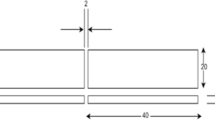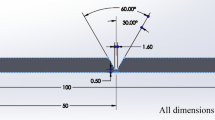Abstract
In the last few decades, researchers proceeded their foot for analyzing the weld characteristic index of materials since the development of novel materials began tremendously. Presently, evaluation of the optimum synchronization among considered input factors for materials are even now surviving into ill-defined mode; soliciting novel mathematical models as well as robustly designed decision support systems that could effectively handle nonpartial information (experimental data). In the present reporting, multiobjective optimization dilemmas have been answered in metal inert gas (MIG) welding process using MS plate (Grade: IS 2062) specimen. The considered specimen was checked to harmonize the optimum setting between input factors, for example, welding current, open circuit voltage, and thickness of plate, with respect to obtaining prosperous weld strength as well as bead geometry quality characteristics, for example, tensile strength, bead width, reinforcement, penetration, and dilution. In the present research work, the Taguchi’s L9 orthogonal array (OA) design was preferred to conduct the experiments on MS plate (Grade: IS 2062) specimens in the domain of MIG welding process. Thereafter, the evaluated multiple objectives transformed into a single response via exploration of grey relation analysis (GRA) and principal component analysis (PCA) approaches to determine the optimum setting between input factors. Next, the outset of signal-to-noise ratio (S/N ratio) along with Analysis of variance (ANOVA) productively was utilized to determine the priority weights against the defined input factors (significant factor). The significant contribution of the present report was to propose a robustly designed decision support system that could assist the readers/researchers to resolve the discussed problems.







Similar content being viewed by others
References
Rowlands H, Antony J and Knowles G 2000 An application of experimental design for process optimization. TQM Mag. 12: 78–83
Datta S, Nandi G and Bandyopadhyay A 2009 Application of entropy measurement technique in grey based Taguchi method for solution of correlated multiple response optimization problems: a case study in welding. J. Manuf. Syst. 28: 55–63
Chandel R S, Seow H P and Cheong F L 1997 Effect of increasing deposition rate on the bead geometry of submerged arc welds. J. Mater. Process. Technol. 72: 124–128
Jiang Q, Yajiang L, Juan W and Lei Z 2011 Characterization on strength and toughness of welded joint for Q550 steel. Indian Acad. Sci.. Bull. Mater. Sci. 34: 161–167
Farias J P, Scotti A, De P S, Balsamo S and Surian E 2004 The effect of wollastonite on operational characteristics of AWS E6013 electrodes. J. Brazilian Soc. Mech. Sci. Eng. 26: 317–322
Tarng Y S, Juang S C and Chang C H 2002 The use of grey-based Taguchi methods to determine submerged arc welding process parameters in hardfacing. J. Mater. Process. Technol. 128: 1–6
Lung K P, Wang C C, Wei S L and Sher H F 2007 Optimizing multiple quality characteristics via Taguchi method-based Grey analysis. J. Mater. Process. Technol. 182: 3107–116
Ilo S, Just C and Xhiku F 2012 Optimisation of multiple quality characteristics of hardfacing using grey-based Taguchi method. Mater. Des. 33: 459–468
Bai Y, Gao H M and Qiu L 2010a Droplet transition for plasma-MIG welding on aluminium alloys. Trans. Nonferrous Metals Soc. China 20: 2234–2239
Bai Y, Gao H M, Wu L, Ma Z H and Cao N 2010b Influence of plasma-MIG welding parameters on aluminum weld porosity by orthogonal test. Trans. Nonferrous Metals Soc. China 20: 1392–1396
Zhang L J, Ning J, Zhang X J, Zhang G F and Zhang J X 2015 Single pass hybrid laser-MIG welding of 4-mm thick copper without preheating. Mater. Des. 74: 1–18
Maggiolino S and Schmid C 2008 Corrosion resistance in FSW and in MIG welding techniques of AA6XXX. J. Mater. Process. Technol. 197: 237–240
Nagesh D S and Datta G L 2002 Prediction of weld bead geometry and penetration in shielded metal-arc welding using artificial neural networks. J. Mater. Process. Technol. 123: 303–312
Murugan N and Gunaraj V 2005 Prediction and control of weld bead geometry and shape relationships in submerged arc welding of pipes. J. Mater. Process. Technol. 168: 478–487
Shen S, Oguocha I N A and Yannacopoulos S 2012 Effect of heat input on weld bead geometry of submerged arc welded ASTM A709 Grade 50 steel joints. J. Mater. Process. Technol. 212: 286–294
Lee J I and Um K W 2000 A prediction of welding process parameters by prediction of back-bead geometry. J. Mater. Process. Technol. 8: 106–113
Author information
Authors and Affiliations
Corresponding author
Rights and permissions
About this article
Cite this article
Sahu, N.K., Sahu, A.K. & Sahu, A.K. Optimization of weld bead geometry of MS plate (Grade: IS 2062) in the context of welding: a comparative analysis of GRA and PCA–Taguchi approaches. Sādhanā 42, 231–244 (2017). https://doi.org/10.1007/s12046-016-0589-1
Received:
Revised:
Accepted:
Published:
Issue Date:
DOI: https://doi.org/10.1007/s12046-016-0589-1




